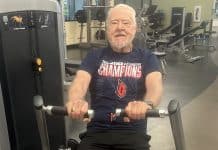Older people who go to the gym reap the rewards of better mobility, decreased reliance on their caregivers for tasks and increased autonomy over their lives. However, are traditional workouts appropriate for our older family relatives? Should we encourage our aging parents to engage in intense physical fitness?
What Entails Traditional Gym Workouts?
The Centers for Disease Control (CDC) suggests people 65 and older combine aerobic, balance and muscle-building activities weekly. The general movement recommendation is at least 150 minutes at moderate intensity or 30 minutes daily, five times weekly. At least two days should be dedicated to strengthening muscles, and other days to improving balance.
The CDC provided an example to ensure every older adult meets the physical activity benchmark. Here’s what it will look like:
- Brisk walking or any aerobic activity for 30 minutes daily for five days
- Lifting weights to strengthen major muscle groups for two or more days on top of the 30-minute cardio
- Some balance exercises
Since there’s no recommended number of days for balance routines, you can sequence a few sets and reps after aerobics and strength training.
Are Conventional Workouts Suitable for Older People?
You can do traditional gym workouts as long as you’re healthy and have intact mobility. Many older adults retire in good health, can live independently and physically afford strenuous exercises. Some even develop monstrous strength to lift several pounds of weight.
The key to this is increasing physical activity as you age, which opposes popular belief. People often advise against doing intense activities because they risk joint pain and injuries. However, the opposite is true for staying strong and coordinated throughout your golden years. It becomes essential to exercise more frequently at the gym.
The gym offers a safer place for older people to stay active. Modern gym floors are made of unique materials that absorb 22%-40% of the shock from lifting weights or other routines, making them gentler on the joints than the harder floors in your home.
What Are the Benefits of Exercise for Older Adults?
Training at the gym has immediate and long-term merits. Working out reduces stress and blood pressure and enhances sleep quality. It can also decrease the risk of chronic diseases like dementia — a progressive condition that affects millions every year and results in the loss of independence due to severe cognitive decline.
Exercise is a panacea for heart disease, stroke and Type 2 diabetes. The daily grinds at the gym can keep your weight in check, lowering the incidence of heart attack or stroke due to obesity. Working out can also help our loved ones sidestep at least eight types of cancers, including bladder, breast and colon.
If you patiently train three to five times a week, you should be able to see changes in your strength, balance and mobility within a month. If not, be patient and continue with the routines. You’re bound to feel and see a positive difference.
What Are Considerations When Adopting Traditional Workouts?
Injuries can happen if you do a deadlift without engaging the right muscles or squat improperly. Older individuals are advised to work with a training coach to tailor their routines to their current needs and abilities. A personalized workout plan can help avoid accidents during workouts.
Some of our older relatives have conditions that restrict the type of training they can do. In this case, encourage them to explore senior-friendly alternatives like aquatic workouts, chair exercises, yoga and tai chi. These activities are low-impact and kind to the joints.
Adopt an Active Lifestyle
Older adults can do traditional gym workouts if their physical ability allows it. Before starting your training, consult your doctor and ask if there are precautions you can take to protect yourself from injuries. Work with a gym coach to customize an exercise plan tailored to your abilities and eliminate the risk of injuries.
























